For generations, hunters have pursued deer, yet the question of precisely where to shoot a deer for a swift, ethical harvest remains a subject of ongoing discussion. Whether you’re a seasoned rifle hunter debating high-shoulder versus behind-the-shoulder shots, or a bowhunter navigating the complexities of modern arrow placement, understanding the vital areas of a deer is paramount.
The good news is that many commonly discussed aiming points are indeed effective. The “best” location often depends on individual preferences, hunting scenarios, and desired outcomes. This guide breaks down the optimal shot placements for deer hunting with both firearms and archery equipment, ensuring a humane and successful hunt.
Understanding Deer Anatomy for Ethical Hunting
Before delving into specific aiming points, it’s crucial to understand basic deer anatomy. The primary target area for a quick and ethical kill is the heart and lung region. This vital zone is situated between and slightly behind the front shoulders, roughly in the middle of the deer’s body vertically.
- Heart: Located low in the chest cavity, tight to or slightly ahead of the shoulder crease.
- Lungs: Occupy a large area between the shoulders and extend rearward, approximately one-third of the way into the flank.
- Shoulder Bones (Scapula and Humerus): Dense bones that can impede penetration, especially with archery equipment. Understanding their position is key to avoiding them or strategically utilizing them in shot placement.
- Spine: Located along the deer’s back and neck, a direct hit can result in immediate incapacitation.
While shots to other areas can be lethal, the heart-lung area offers the largest margin for error while maximizing the chances of a rapid, humane kill. This is why it’s the primary focus for responsible hunters using both rifles and bows.
Where to Shoot a Deer with a Rifle: Top Aiming Points
Having spent decades observing deer behavior and shot effectiveness, experienced rifle hunters recognize that while deer are not exceptionally difficult to kill compared to larger game like elk, precise shot placement remains critical. Here are four reliable aiming points for rifle hunters:
1. The Classic Behind-the-Shoulder Lung Shot
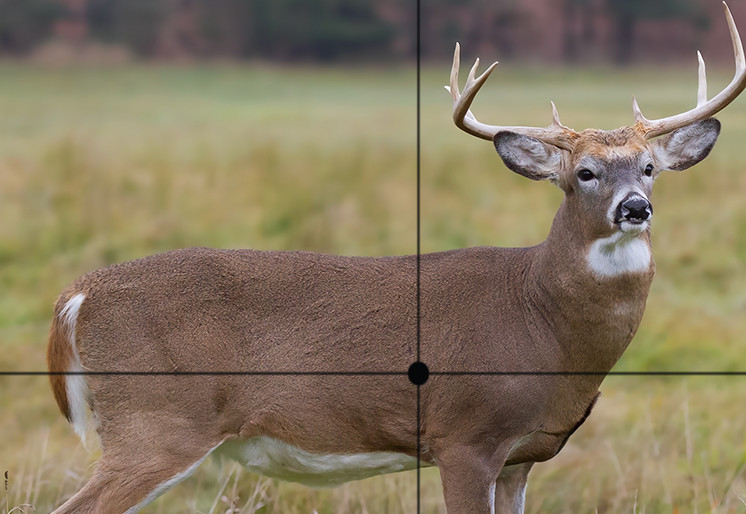 Behind-the-shoulder lung shot placement for deer hunting
Behind-the-shoulder lung shot placement for deer hunting
A well-placed behind-the-shoulder shot maximizes lung damage and preserves meat.
The behind-the-shoulder shot is often considered the “money shot” for rifle hunters due to its large target area and minimal meat damage. Aim for a point one-third to halfway up the body, just behind the front leg. Visualize picking a specific spot in this region and focus on a controlled trigger squeeze.
This shot placement virtually guarantees lung penetration, often damaging both lungs and potentially the heart. It’s particularly effective when using fast-expanding bullets, as there are no major bones to hinder expansion and energy transfer. Ammunition like Browning BXR and Winchester Deer Season are excellent choices for this shot.
2. The Devastating High-Shoulder Shot
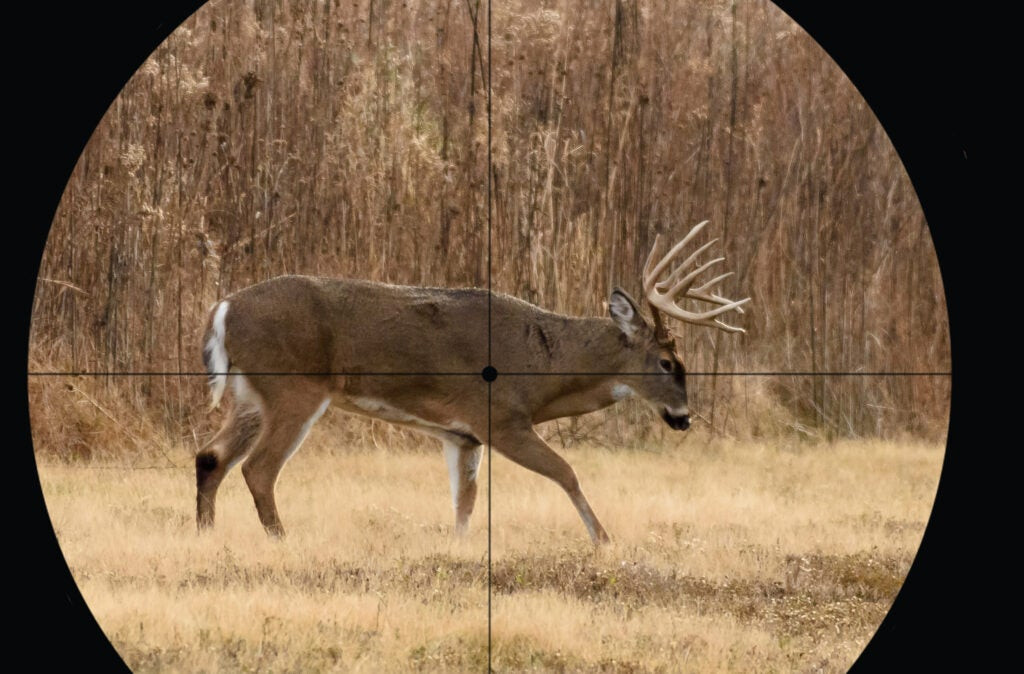 High-shoulder shot placement for rifle deer hunting
High-shoulder shot placement for rifle deer hunting
The high-shoulder shot is known for its immediate stopping power, often dropping deer in their tracks.
The high-shoulder shot is a preferred choice for hunters who prioritize immediate incapacitation. Aim for a point one-half to two-thirds up the body, slightly forward of the center of the shoulder.
This shot reliably targets the lungs and significantly increases the likelihood of impacting the shoulder blade and the upper spine. The resulting trauma often drops deer instantly or within a few yards. Controlled-expansion bullets are recommended for this shot, ensuring sufficient penetration to reach vital organs while still providing adequate expansion upon impact.
3. The Effective Face-On Chest Shot
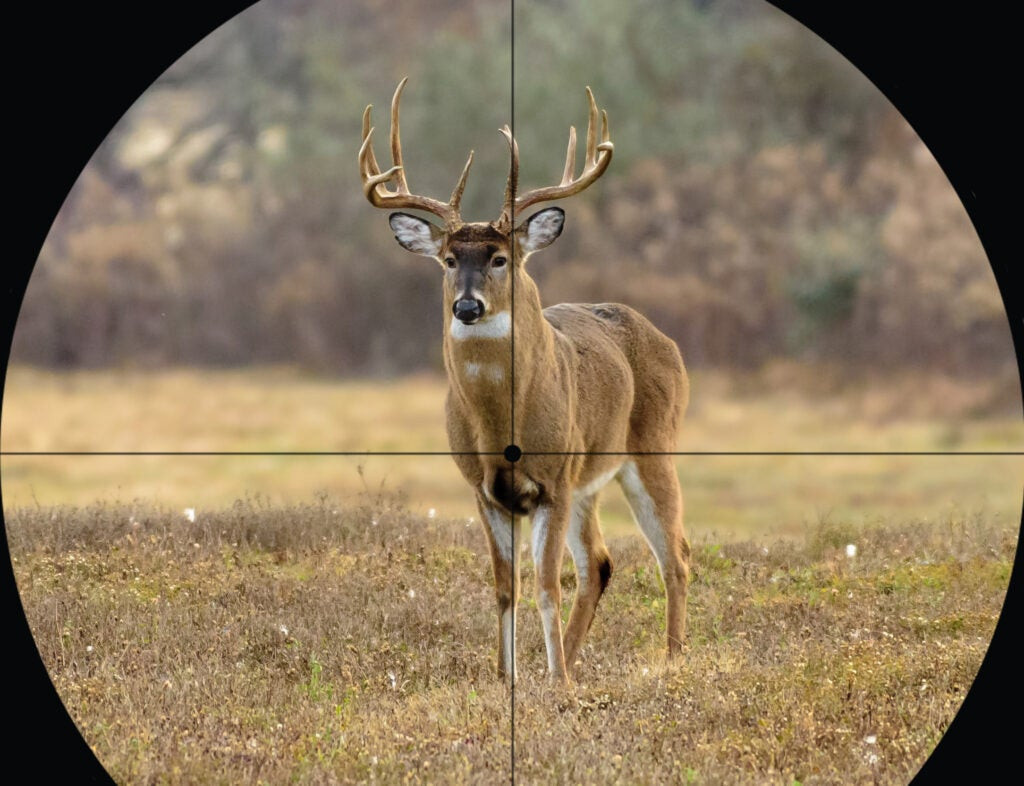 Face-on chest shot for deer hunting
Face-on chest shot for deer hunting
A frontal chest shot is highly effective when a deer is facing you directly.
When a deer is facing you directly, the face-on chest shot is an extremely effective option. Aim directly for the center of the chest.
A bullet placed here will traverse both lungs and the heart, resulting in rapid incapacitation. Deer rarely run after a well-placed frontal chest shot. If the deer is quartering-to, adjust your aim to the point of the shoulder on the near side to achieve a similar vital organ hit and facilitate easier blood trailing if necessary.
4. The Precise Back of the Neck Shot (Facing Away)
While neck shots from the side are generally discouraged due to the higher risk of wounding, a shot to the back of the neck when a deer is facing directly away can be a humane option in specific circumstances.
Aim for the base of the neck, directly in the center. This shot targets the spine, which is larger at the base of the neck than the spinal column further up. A solid bullet is crucial for this shot to ensure penetration and spinal disruption. This shot should only be considered when the deer is facing directly away, providing a clear and ethical shot opportunity.
Where to Shoot a Deer with a Bow: Optimal Aiming Locations
Bowhunting demands precise shot placement due to the different mechanics of arrow versus bullet lethality. Traditionally, avoiding the shoulder was paramount in bowhunting. However, modern equipment and techniques have broadened acceptable aiming points. Here are four effective locations for bowhunters:
1. The Time-Tested Behind the Shoulder Bow Shot
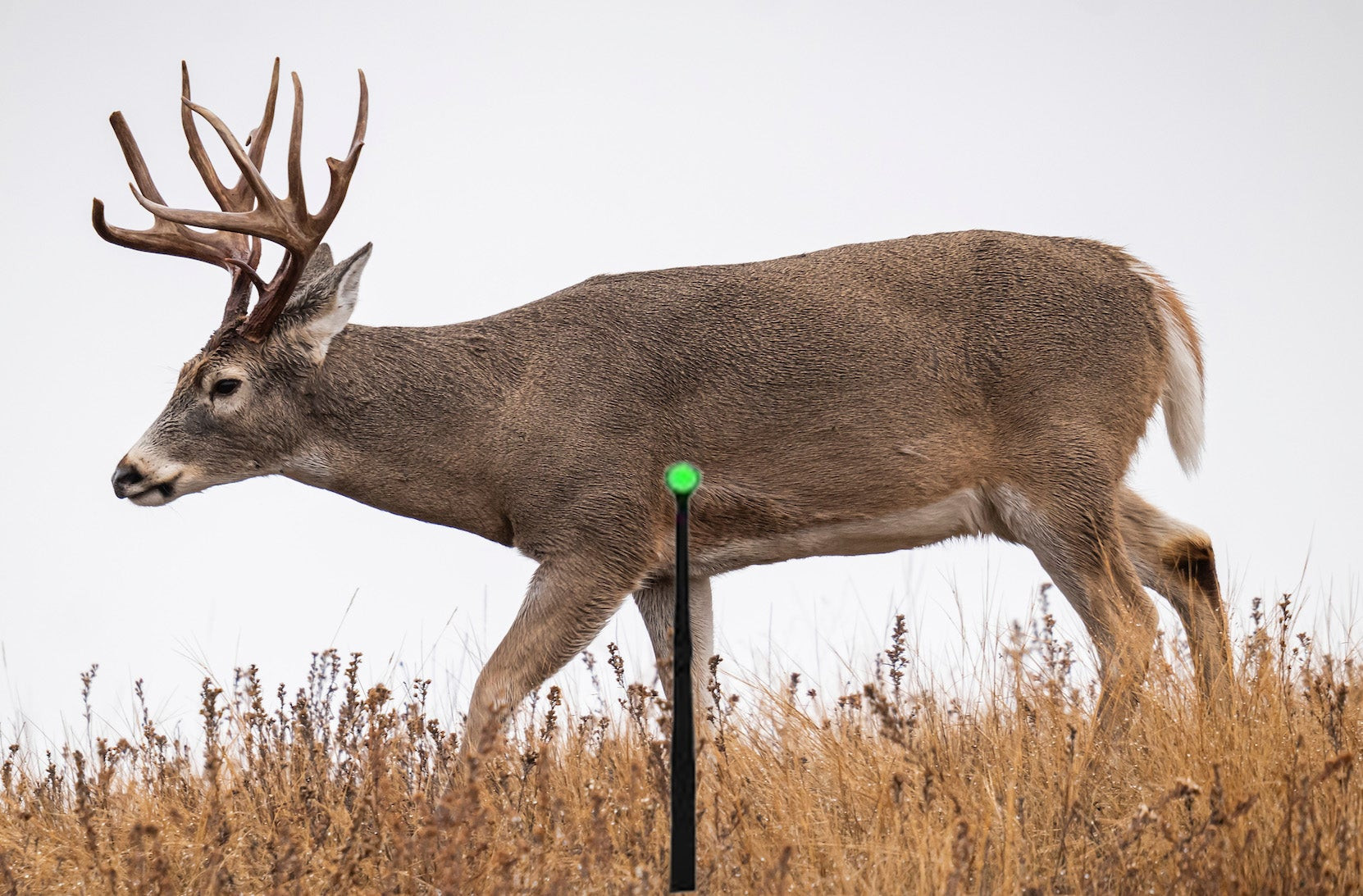 Behind-the-shoulder shot placement for bow hunting deer
Behind-the-shoulder shot placement for bow hunting deer
The behind-the-shoulder shot remains a reliable choice for bowhunters, ensuring lung penetration.
The behind-the-shoulder shot remains a cornerstone of bowhunting shot placement. For a broadside deer, aim one to two inches behind the shoulder crease, horizontally centered on the body.
This aiming point ensures the arrow passes cleanly through both lungs while avoiding the shoulder bones. It offers a degree of forgiveness, meaning even slight deviations in shot placement are likely to still result in a lethal hit within the lung cavity.
2. The Vital-V Shot: Modern Bowhunting Accuracy
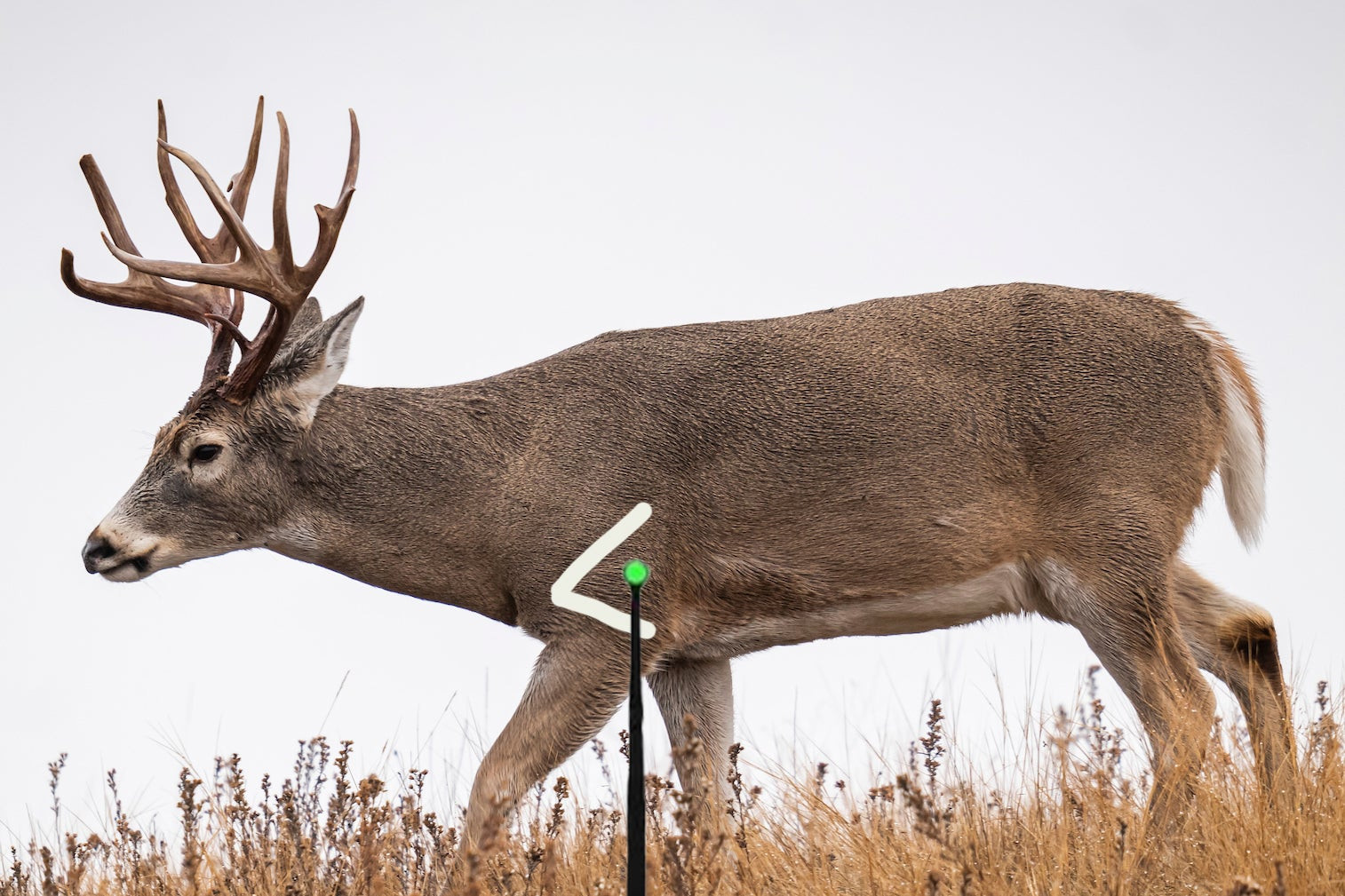 Vital-V shot placement for bow hunting deer
Vital-V shot placement for bow hunting deer
The Vital-V targets the forward lungs and upper heart, a highly effective area for bowhunters.
The “Vital-V” shot represents a more contemporary approach, targeting the area just in front of the shoulder crease. The “V” refers to the space formed by the trailing edges of the scapula (shoulder blade) and humerus (upper leg bone).
This aiming point targets the forward section of the lungs, major pulmonary vessels, and the top of the heart. A well-placed Vital-V shot often results in deer expiring within sight. While it may involve contacting bone if the shot is slightly high or forward, modern heavy, high-F.O.C. (Front of Center) arrows paired with tough, fixed-blade broadheads are designed to penetrate these bones effectively.
3. The Advantageous Quartering-Away Shot
The quartering-away shot is widely considered the ideal shot angle for bowhunters. It presents a clear path to the vital organs while easily bypassing the near shoulder.
For a quartering-away deer, aim to exit through the far shoulder. Visualize following the far leg upwards to the mid-body and aim for that point. This trajectory ensures the arrow passes through the heart and lungs, often resulting in a double-lung hit and potentially the heart as well. Tracking distances are typically short with this shot placement.
4. Quartering-To Shot Options (Proceed with Caution)
When a deer is quartering-to at a slight angle, a shot can still be ethically taken by experienced bowhunters. Aim tight to the shoulder crease or at the Vital-V area.
A well-placed arrow can penetrate both lungs, leading to a successful harvest. However, hard quartering-to angles should generally be avoided by bowhunters, especially those less experienced. The key consideration is the exit point of the arrow. If the anticipated exit point is too far back to confidently ensure double-lung penetration, refrain from taking the shot.
Some modern bowhunters using heavy, high-F.O.C arrows and deep-penetrating fixed-blade broadheads may attempt shots at harder quartering-to angles by aiming for the soft spot crease between the chest and shoulder, intending for the arrow to exit behind the far shoulder. While effective, this shot requires expertise and precise equipment and is generally considered a more advanced technique.
Choosing the Right Gear: Bullets and Broadheads for Deer Hunting Success
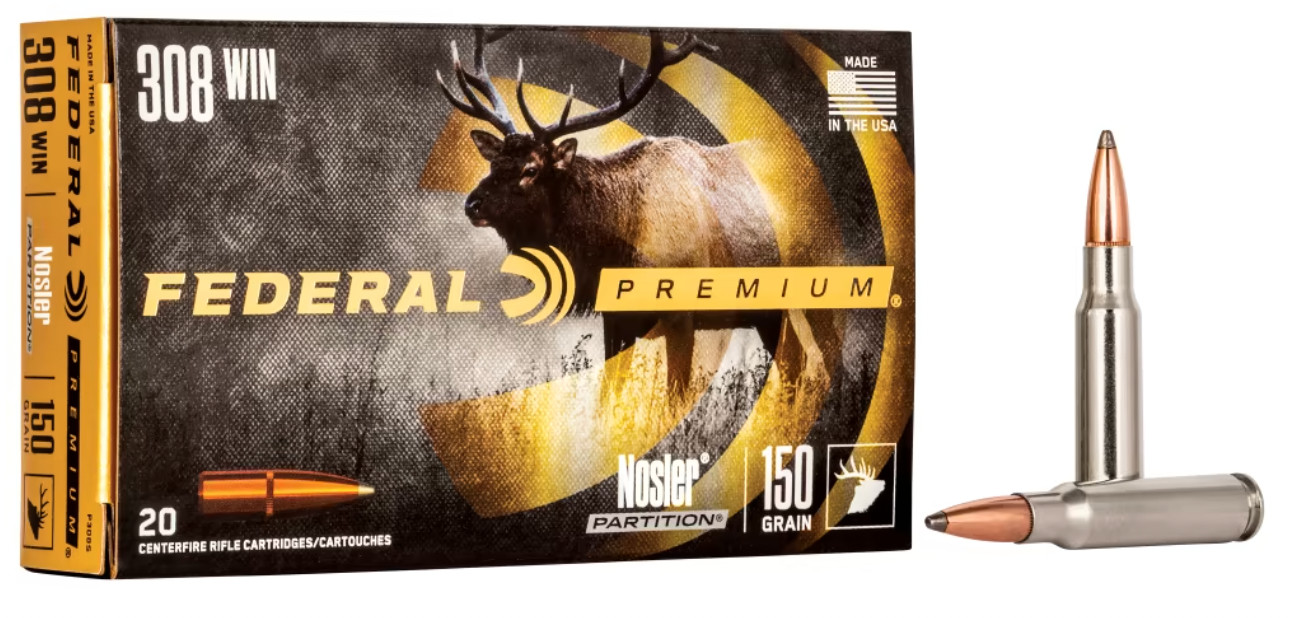 Federal Nosler Partition bullets for deer hunting
Federal Nosler Partition bullets for deer hunting
Reliable bullets and broadheads are essential for ethical and effective deer hunting.
For rifle hunters, bullet selection is paramount. While cartridge choice plays a role, bullet construction significantly impacts performance. Both tough bullets and quick-expanding bullets have their place in deer hunting, depending on shot placement and personal preference.
Tough bullets, such as Barnes TSX, Swift Scirocco, Swift A-Frames, and Nosler Partitions, are designed for deep penetration, bone-breaking capability, and reliable exit wounds. They are excellent choices for hunters prioritizing penetration and consistent performance across various shot angles.
For bowhunters, the trend leans towards heavy, micro-diameter arrows with high F.O.C. These arrows offer enhanced penetration, crucial for overcoming bone resistance and achieving pass-through shots. When aiming for the Vital-V or anticipating shots that may encounter bone, these arrow setups paired with tough, fixed-blade broadheads are highly recommended.
For behind-the-shoulder shots on broadside deer, some bowhunters prefer wide-cutting mechanical broadheads. However, even with this shot placement, using a heavier arrow and a robust broadhead is advisable to ensure adequate penetration in case of slight aiming errors.
Shots to Absolutely Avoid When Deer Hunting: Ensuring Ethical Harvest
Ethical hunting demands responsible shot selection. Certain shot placements should be avoided entirely to minimize the risk of wounding and ensure a humane harvest.
1. Head Shots: High Risk, Low Reward
Head shots should be avoided with both firearms and bows. The head presents a small, moving target, significantly increasing the chance of a non-lethal wound. Even if a head shot is instantly fatal, it can result in a gruesome and disrespectful outcome. More concerning is the potential for wounding the deer, such as shooting off the lower jaw, leading to prolonged suffering and a lingering death.
2. Base of the Tail Shot (Texas Brain Shot): Unreliable and Unethical
The “Texas Brain Shot,” aimed at the base of the tail, is sometimes suggested as a way to prevent a wounded deer from escaping. However, this shot is highly unreliable and unethical as a primary aiming point. While a precise hit to the base of the spine can immobilize the deer’s hind legs, the margin for error is extremely small. More likely, this shot will result in a gut shot, causing severe suffering and a prolonged, inhumane death. This shot should never be considered as an initial aiming point.
3. Any Unsure Shot: Patience is Key to Ethical Hunting
Perhaps the most critical aspect of ethical shot placement is knowing when not to shoot. If you are unsure about the shot, the deer’s position, or your ability to make a precise hit, take your finger off the trigger and wait. Deer are constantly moving, and a better shot opportunity often presents itself with patience.
Learn to read deer body language. A relaxed deer offers more time to assess the situation and wait for an optimal shot. A tense, alert deer may bolt at any moment, requiring a quick but still ethical decision. If a good shot is not available, or if doubt exists, the responsible decision is to let the deer pass.
Conclusion
Knowing where to shoot a deer is fundamental to ethical and successful hunting. By understanding deer anatomy, practicing shot placement, and choosing appropriate equipment, hunters can ensure quick, humane kills and responsible game harvests. Whether you prefer a rifle or a bow, mastering these aiming points and prioritizing ethical shot selection will contribute to a respectful and fulfilling hunting experience.

